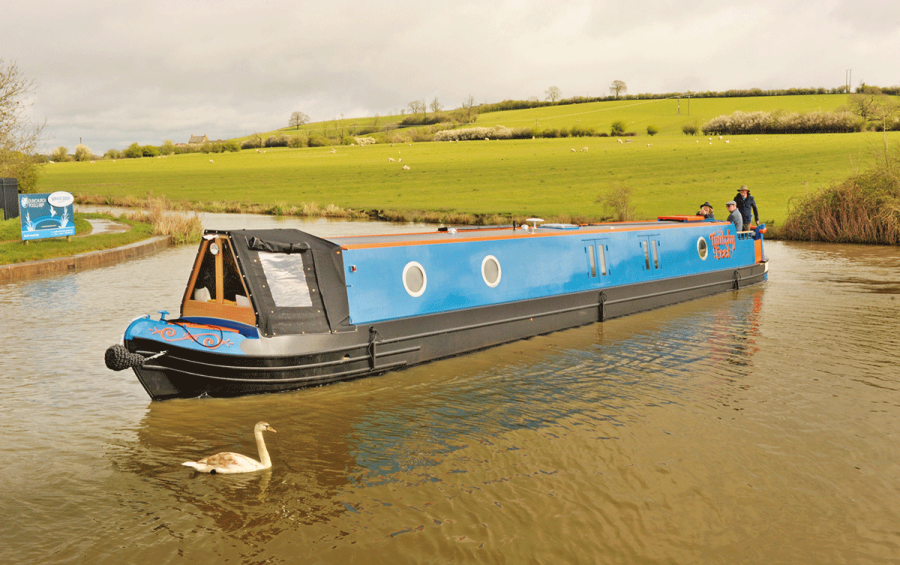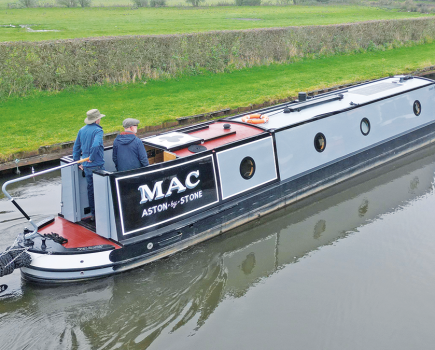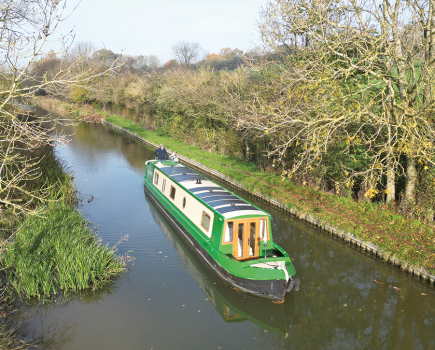A 59ft metallic blue, electric-powered semi-cruiser.
Words by Adam Porters | Pictures by Andy Annable
Sometimes, you think you’ve got everything all planned out, when life knocks you sideways. Mandy and Ian Whitton first approached Chris Smith of Smithwood Narrowboats about building them a boat in late 2021, after decades of hire boat holidays. A few months later, Ian was diagnosed with a brain tumour. “You just don’t know how long you’ve got left,” he says “so you have to get on with it.”
Treatment takes a while, and builders often have build slots booked up years in advance – but the couple say Smithwood pulled out all the stops to get their boat built sooner. And they made some changes to take into account their new reality: Ian can’t do everything he used to be able to do.
The result is a boat which is well equipped for living on board, has electric propulsion, bow and stern thrusters to help Mandy single-hand, and plenty of accommodation for their large family to visit.
EXTERIOR
Twitchy Feet is a 59ft semi-cruiser, built on a shell by Tim Tyler. As you’d expect from such a well-respected name, the steelwork looks excellent. There’s a curvy Josher-style bow, and because the boat is gas-free, the locker in the nose is available for storage. There’s a traditional wooden cratch board and cover over the well deck. A locker across the deck has cushions, making it a comfortable place to sit, and there’s a table which slots in. The water tank is underneath the deck.
At the stern, there’s a metal dodger round the back of the deck, but it has a shapely cut out so it doesn’t look too heavy. It has built-in seating – and there’s more, thanks to the lockers either side of the deck. These have railings with a hardwood top to provide a backrest, and there’s another slot for a table. All the seating out here has made-to-measure cushions. The area is enclosed by little doors, which have been shaped so they can open inwards, and the deck itself is covered in a smart teak-effect finish (which is also used on the locker lids).
The colour scheme is a bold metallic blue teamed with a bright orange – inspired by the plumage of kingfishers, which the owners love to see. It’s the first time Smithwood has used a metallic paint; it had a dozen coats, so is no simple task to apply – but the end result looks good. The metallic aspect is quite subtle, but there’s a nice depth and sparkle, particularly in sunshine.
The signwriting is by Charlotte Hopwood of Seawood Signwriting, to a design by the owners’ son’s girlfriend. It can’t help but raise a smile.
The roof is painted black, which helps disguise the two huge solar panels. The painted sections are in Raptor paint, which is non-slip without having to mix anything into it.
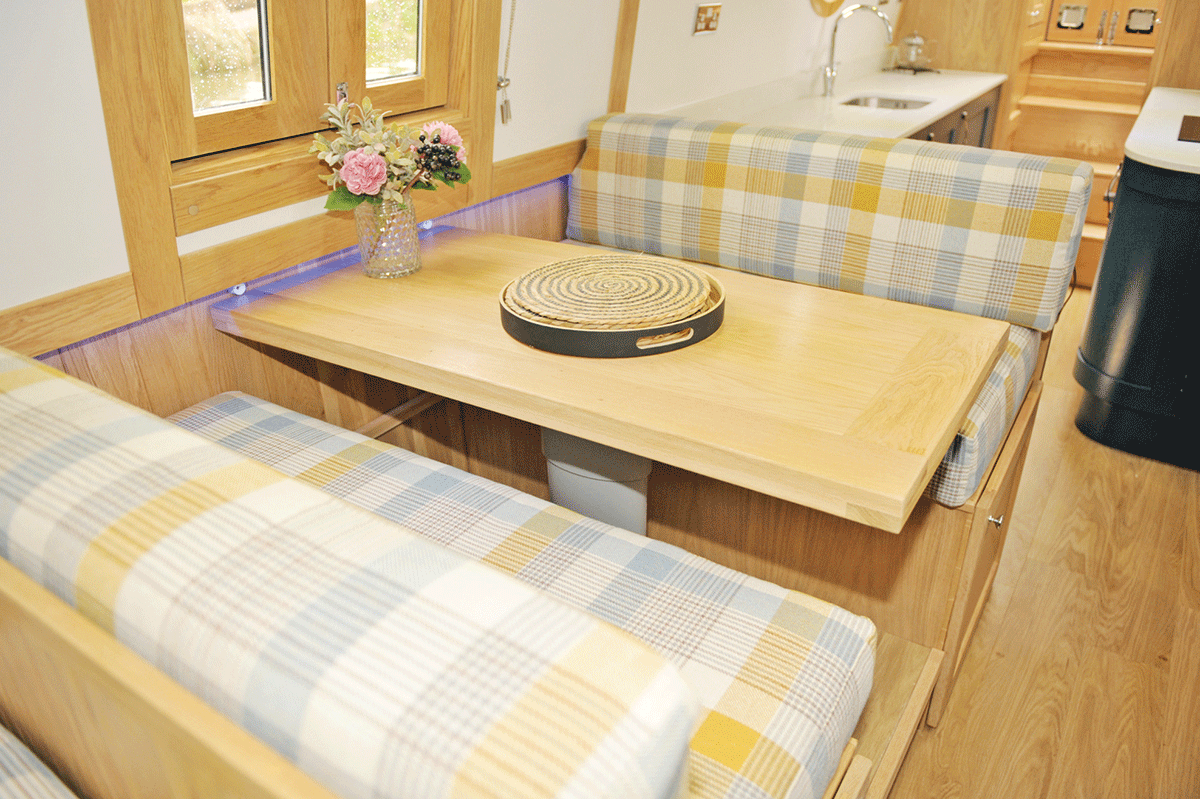
LAYOUT AND FITOUT
This is a reverse layout boat, with the galley at the stern. Next comes a Pullman dinette, followed by the saloon. A walk-through shower room is next, with the cabin at the bow.
The fitout uses oak tongue and groove below the gunwales, with painted panels above. It means the interior is light and bright, and feels spacious. All the trim and built-in furniture is oak. Chris Smith started as a joiner, so everything is nicely made. The floor is Amtico LVT in an oak finish, but it’s the sort which clicks together rather than needing to be glued down.
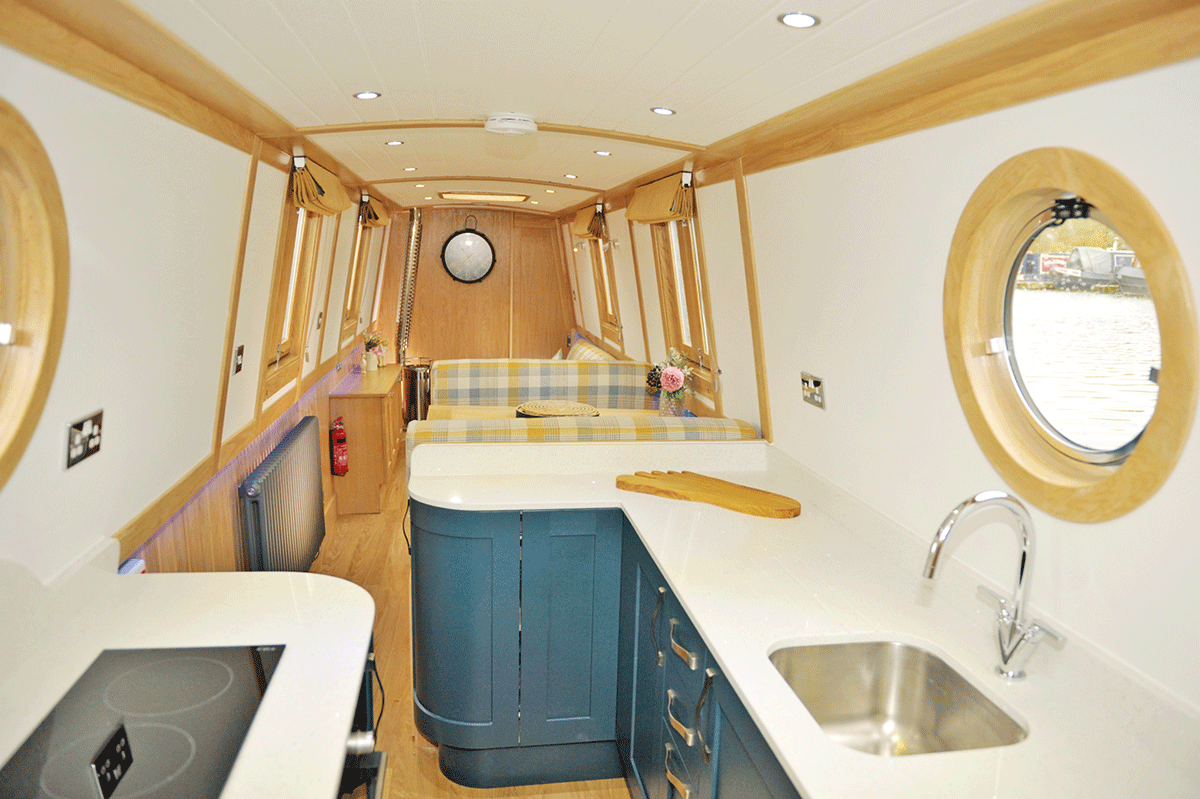
GALLEY
Three steps lead down from the stern deck into the galley. The bottom two steps are drawers for storage. Either side of them are cupboards, one of which contains the electrics such as the inverter.
The galley units are from Howdens, and have doors in a dark blue. The curved ones at the ends of the unit runs are particularly nice. There’s a combination of cupboards and drawers, including some making use of the plinth space. The worktops are a pale sparkly Quartz, and the splashback behind the hob has a curve which mirrors the porthole above. The sink is an undermounted stainless steel one, with a smart arched tap. It’s a well equipped galley, with a CDA two ring induction hob, and a Bosch electric oven. The integrated fridge is a 240-volt model by Hisense, and there’s a pull-out freezer in the end of one of the dinette benches. A washer-dryer is also hidden behind a door. An amusing touch is the foot-shaped wooden chopping board, bought from the Christmas market in Winchester, when the boat was still in the planning stage.
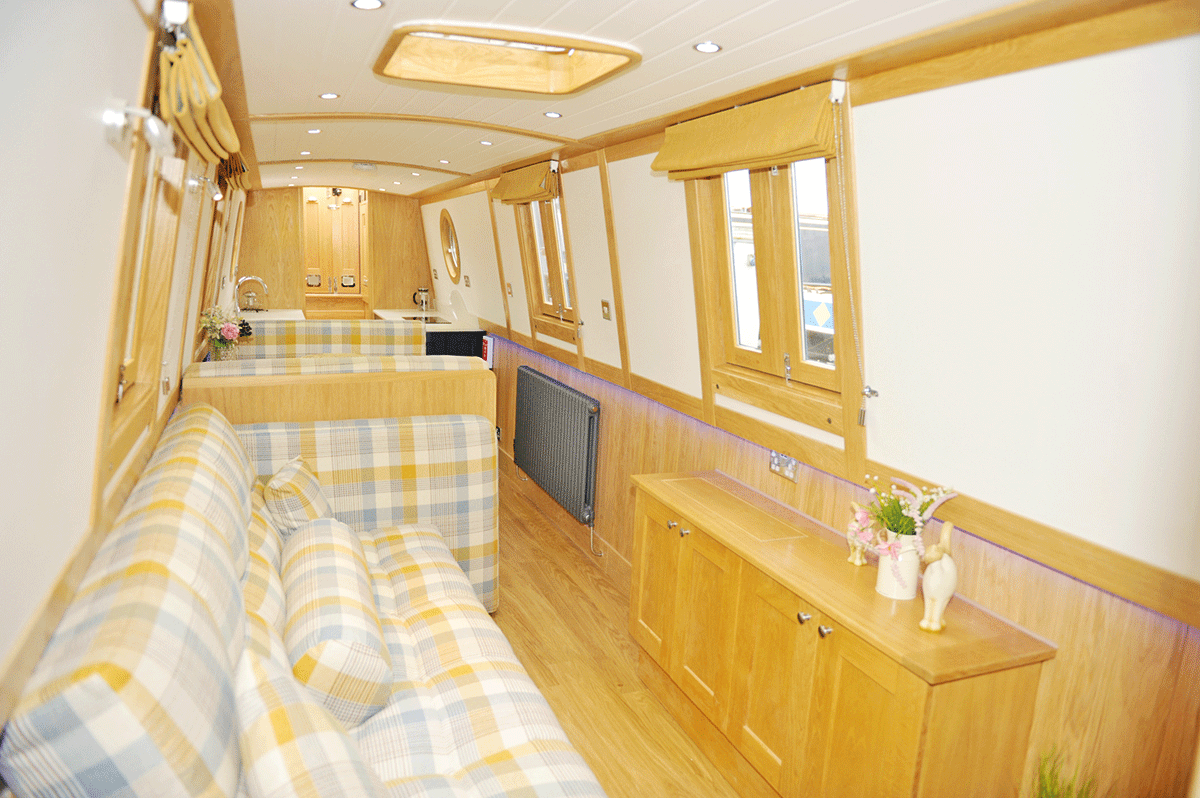
DINETTE AND SALOON
The dinette is Pullman style, and converts very easily to a guest bed. The table is on a hydraulic leg, and lowers when you pull a lever; it’s become a bit of a Smithwood trademark. Mandy was in charge of the interior design, so chose the check fabric for the dinette and sofa; it’s light and bright, and works really well in the space. There are glazed side doors above the table and opposite, meaning you always have a view.
In the saloon, the sofa also converts into a bed. At one end, the arm is oversized to fit the dinette bulkhead – meaning there’s something soft to lean against, and acts as a headboard when it’s used as a bed.
Opposite the sofa is a substantial unit, which houses a tv which rises electrically at the press of a button. It means the tv doesn’t have to be on show all the time – but of course does take up quite a bit of cupboard space. The sockets have USB ports for charging.
A Refleks diesel stove sits on a raised plinth in the corner of the room. It was chosen so there are no bags of coal or logs to lug about, and because it won’t create dust like a solid fuel stove would – something important for Ian’s recovery.
There are more glazed side doors in this room, with blinds which are held in place by magnets when they’re lowered. Extra daylight comes from a Houdini hatch in the ceiling.
SHOWER ROOM
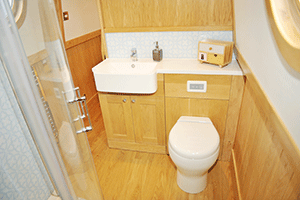 The walk-through shower room features a quadrant shower, generously sized at 800x800mm. It’s lined with an acrylic shower panel, printed with a geometric design. Alongside, between the cubicle and the cabin sides, are pullout units. The bottom one has room to store towels, while the upper one, which gets narrower because of the tumblehome, is great for spare loo rolls and other supplies.
The walk-through shower room features a quadrant shower, generously sized at 800x800mm. It’s lined with an acrylic shower panel, printed with a geometric design. Alongside, between the cubicle and the cabin sides, are pullout units. The bottom one has room to store towels, while the upper one, which gets narrower because of the tumblehome, is great for spare loo rolls and other supplies.
Across the boat is a unit which has the Tecma macerating loo on one side, and a cupboard under the basin alongside. The basin itself is moulded into the worktop; the splashback is more of the geometric panel, helping to bring the whole room together. The loo holding tank is under the bed, but to maximise storage space it’s on one side of the boat, meaning it could affect the trim slightly as it fills.
At either end of the room are pocket doors which disappear into the bulkhead walls. They’re an efficient use of space, as there’s no swinging room required, and they lock into place when they’re open.
CABIN
A cross bed was chosen for this boat, so there’s a decent amount of space on both sides. To make life easier, there’s no pulling or pushing required for the infill section. Just press a button on a little fob, and the bed base moves out electrically; then the extra section of mattress fills the space.
There’s storage in the bed base. To get to it, the front panel slides either left or right. It’s easier than pulling a big drawer, but of course you can only get to one side at a time. Cubby holes mean there’s place to put a glass of water, and they have charging points too.
There’s plenty of space for clothes, with sizeable wardrobes on each side of the bed. There are a couple of high level cupboards too, with an attractive arch over the porthole, and reading lights underneath.
A couple of space-saving steps lead up to the well deck, with drawers in the fronts. You just have to remember to start with the correct foot when you come back in!
TECHNICAL
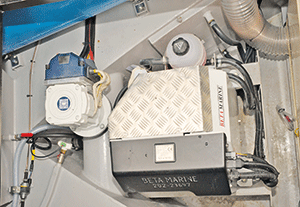 The owners originally wanted a parallel hybrid system, so the boat could be powered by both diesel and electric. But long lead times caused by the post-pandemic disruption to supply chains meant they were forced to re-think. With everything that was going on, they just couldn’t wait. So this boat has all electric propulsion, using a Beta Marine system. The electric motor is the Beta E-drive, delivering 14kw continuous power, and up to 25kw intermittently. It’s cooled by a water jacket, and comes with an LCD display so you can see how much power is being used, and joystick control.
The owners originally wanted a parallel hybrid system, so the boat could be powered by both diesel and electric. But long lead times caused by the post-pandemic disruption to supply chains meant they were forced to re-think. With everything that was going on, they just couldn’t wait. So this boat has all electric propulsion, using a Beta Marine system. The electric motor is the Beta E-drive, delivering 14kw continuous power, and up to 25kw intermittently. It’s cooled by a water jacket, and comes with an LCD display so you can see how much power is being used, and joystick control.
The motor is teamed with a BetaGen10 generator to keep the batteries charged. It’s enclosed in a cocoon to keep the noise down. The batteries themselves are a large bank of traction cells, giving 800Ah at 48 volts. As well as the generator, they can be charged by shore power, and by the two huge semi-flexible solar panels on the roof. Each one is 500 watts, so there’s a full kilowatt up there. During the summer, it’s likely the solar array will be sufficient to make generator running a rarity rather than the norm.
One of the potential problems with serial hybrid systems in the past, was that it was up to boat builders or owners to pick a motor from those available and pair it with one of the many generators on the market – then try to make sure everything worked together properly. So it’s good to see big names like Beta Marine putting together a system. It’s been out for a little while now, but this is the first time we’ve tested a boat fitted with it. Smithwood have used the same set up in previous builds, and say that (so far at least) they’ve been trouble free.
There’s an 8kw Victron 48 inverter charger to give a 240-volt supply. The 12 volt systems on board, like the lighting and pumps, have their own batteries, charged from the main bank. A Victron Cerbo GX monitoring system has a display which shows what’s going on with the whole electrical system – including how much power is being used, and what’s being generated. All the information is also available on a smartphone app.
The Cerbo system also manages the generator, so it’s programmed to come on automatically when the batteries drop to 60 per cent – except at night, when they’d need to drop further before it kicked in (after all, no-one wants to be woken up by a generator starting up). The generator will also come on if the motor is using more power than normal, for example if you were on a river and were going against the flow. The set-up is designed to protect the batteries from ever getting too low, so whatever happens, you shouldn’t ever find yourself unexpectedly without battery power.
In order that Mandy can handle the boat single-handed when she has to, there are both bow and stern thrusters. They’re the brushless Vetus Bow Pro models, operated by a single joystick. They are proportionate, so you can use a little thrust or a lot; and once you’ve set the thrusters going, the joystick can be locked in position, so for example they could hold the boat into the side while you concentrate on handling the ropes. Central heating is from Webasto.
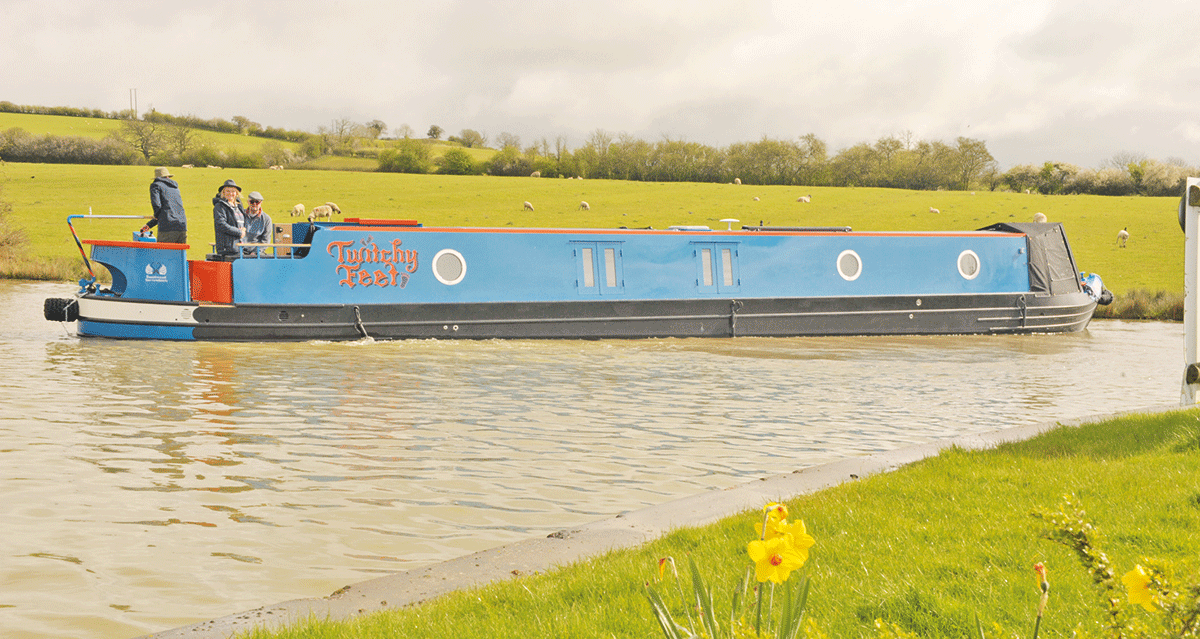
ON THE WATER
We always mention how quiet an electric motor is compared to a diesel engine, but this Beta electric motor seemed particularly quiet. The other impressive thing about it was the power available. We were battling with a fairly strong wind during our test, but I never felt the motor was under-powered.
This also showed how well the boat handled. As is typical with a Tim Tyler shell, if you push the tiller over and apply some power, the bow moves pretty sharply. It makes turning and manoeuvring easy.
The LCD display shows how much power you’re using and the state of the batteries. This boat also has a camera at the bow, with the picture available on the same screen.
The large stern deck is a very sociable space. There’s plenty of room for crew to join whoever’s at the helm, and the seating means they have somewhere comfortable to sit.
CONCLUSION
This boat is striking both inside and out. The colour scheme is unusual enough to stand out, without looking garish. Inside is bright and contemporary, but also homely and relaxing.
The fitout is top quality, and technically the boat has all the latest kit. The Beta E-drive system certainly performed well during our test.
Of course all of this doesn’t come cheap. We’ve been banging on for months about how prices of new boats have risen, thanks to the vastly increased cost of steel and almost every component you can think of. From wood to electric cables, everything costs more than it used to. When you take that into account, the £230,000 price tag for this boat should come as no surprise.
More importantly, Ian and Mandy now have their boat and can begin the next stage of their lives. Ian says that in many ways, it’s easier for him on the boat than at home: everything is on a level once you’re inside, nothing is far away, and there’s always something to hang on to if he feels unsteady. The future may not be exactly how the couple planned it, but it’s happening in spite of everything, and they’re going to enjoy it.
THE OWNERS
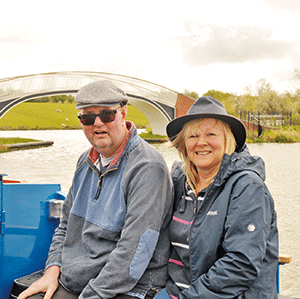 Mandy and Ian Whitton have been boating for more than 30 years – in fact, for Mandy it’s been even longer, as she was taken boating as a child. They’ve spent every Easter holiday on hire boats, choosing a different location each time so they could cover as much of the network as possible. They have a map, where they’ve marked off each route they’ve taken. Before his brain tumour diagnosis, Ian worked for a mining company. The tumour meant he had to stop work. Mandy is a nurse manager at an endoscopy unit, and is also ready to join the ranks of the retired. The couple are planning to live on board, and will spend the summer working their way to a marina in Cambridgeshire, close to where one of their daughters live. Mandy will have to manage handling the boat on her own, although Ian has promised to take over galley duties. Their two daughters and their son have been brought up boating, and all love it – so the plan is that when a flight of locks looms, family members will be called on to come and help. It means the love of boating will also be passed on to the grandchildren.
Mandy and Ian Whitton have been boating for more than 30 years – in fact, for Mandy it’s been even longer, as she was taken boating as a child. They’ve spent every Easter holiday on hire boats, choosing a different location each time so they could cover as much of the network as possible. They have a map, where they’ve marked off each route they’ve taken. Before his brain tumour diagnosis, Ian worked for a mining company. The tumour meant he had to stop work. Mandy is a nurse manager at an endoscopy unit, and is also ready to join the ranks of the retired. The couple are planning to live on board, and will spend the summer working their way to a marina in Cambridgeshire, close to where one of their daughters live. Mandy will have to manage handling the boat on her own, although Ian has promised to take over galley duties. Their two daughters and their son have been brought up boating, and all love it – so the plan is that when a flight of locks looms, family members will be called on to come and help. It means the love of boating will also be passed on to the grandchildren.
Specification
Length: 59ft
Beam: 6ft 10in
Shell: Tim Tyler / www.timtylerboats.com
Style: Semi-cruiser
Layout: Reverse
Berths: 2+2+2
Fit-out: Oak and painted panels
Electric motor: Beta E-Drive / www.betamarine.co.uk
Generator: Beta Gen10 / www.betamarine.co.uk
Bow and stern thrusters: Vetus Bow Pro / www.vetus.com
Inverter: Victron 48 8kw / www.victronenergy.com
CONTACT
Smithwood Narrowboats
Mobbs Wood Farm,
Brinklow Road, Ansty,
CV7 9JN
07786378061
sales@smithwoodnarrowboats.co.uk
www.smithwoodnarrowboats.co.uk
£230,000
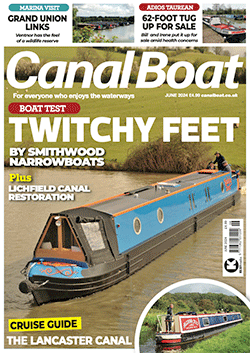 As featured in the June 2024 issue of Canal Boat. Buy the issue here
As featured in the June 2024 issue of Canal Boat. Buy the issue here

